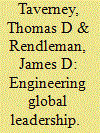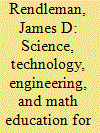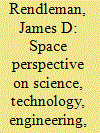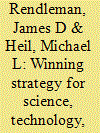|
|
|
Sort Order |
|
|
|
Items / Page
|
|
|
|
|
|
|
| Srl | Item |
| 1 |
ID:
108945


|
|
|
|
|
| Publication |
2011.
|
| Summary/Abstract |
The economic greatness that the United States achieved in the last half of the twentieth century was not assured at the end of World War II. The ascension and U.S. economic juggernaut was secured by three seminal events: (1) the passage of the G.I. Bill; (2) the Soviets' Sputnik launch and the start of the Space Age; and (3) John F. Kennedy's challenge to go to the moon and the subsequent Moon Race. These events spurred the United States to seize and retain leadership in space technology development and space activities; the nation invested in education systems and students, and encouraged a competition that brought out the best from its engineers and scientists and inspired important efforts. The resulting technical genius has fostered advances in a wide variety of other technologies, improving the nation's quality of life. The United States now faces a difficult road ahead unless something is done to reverse recent downward trends in science, technology, engineering, and math education. The authors ask: where is our next G.I. Bill, Sputnik, or Moon Race?
|
|
|
|
|
|
|
|
|
|
|
|
|
|
|
|
| 2 |
ID:
108943


|
|
|
| 3 |
ID:
108946


|
|
|
|
|
| Publication |
2011.
|
| Summary/Abstract |
A senior panel of military and civil space, industrial, and academia leaders recently came together under the auspices of the American Institute of Aeronautics and Astronautics to examine the state of science, technology, engineering, and math education within the United States. They concluded that there is a risk to continued U.S. global space leadership without an effective response and educational innovation and funding for technical challenges that are key to that response. This report summarizes the observations made by the panel members.
|
|
|
|
|
|
|
|
|
|
|
|
|
|
|
|
| 4 |
ID:
101230


|
|
|
|
|
| Publication |
2010.
|
| Summary/Abstract |
The threats to space systems posed by hostile states and non-state actors are evolving. Vulnerabilities span the national security, civil, and commercial space communities. The weaknesses have been studied, and adversaries to the United States and its allies have noted the asymmetric advantages space capabilities provide. They see the tremendous leverage that can be obtained by disrupting them. These adversaries are becoming much more diverse, sophisticated, and technologically competent; they are equipped and able to disrupt access to space capabilities. Defending space systems demands new tools as deterring or eliminating these evolving threats will be difficult. Risk posed by an increasingly dangerous space environment must also be addressed. As it has done for decades, the United States enjoys a unique position in which it can shape the direction of global space activities. With this position comes great responsibility-to forge behaviors to mitigate space debris, deter armed conflict, and enhance the peace, security, and prosperity of spacefaring nations and the rest of the world. A space assurance strategy involving deterrence and defense, global engagement, situational awareness, and responsive infrastructure presents the best opportunity to collectively defend, protect, and secure the high frontier.
|
|
|
|
|
|
|
|
|
|
|
|
|
|
|
|
| 5 |
ID:
108954


|
|
|
|
|
| Publication |
2011.
|
| Summary/Abstract |
The research, innovation, and engineering triumphs of the United States over the past century are a child of a technologically and scientifically superior workforce. That expertise is at risk, however. Recent challenges to acquiring new space systems are attributable, in significant measure, to the loss of science, technology, engineering, and math (STEM) skills and experience. Evolving space mission needs demand improved STEM skills and experience across the spectrum of the space workforce. Unfortunately, many remedial programs have failed, and economic reality confronts the government, industry, and academic establishments as they are challenged to develop education and professional development programs responsive to STEM needs. To continue its leadership in global space activities, the United States needs to employ a comprehensive strategy to ensure it has a workforce with the skills to achieve short-term and long-term success. It can do this by increasing the numbers, and improving the quality of education and academic development of STEM-educated students, graduates, teachers, professors, and their mentors.
|
|
|
|
|
|
|
|
|
|
|
|
|
|
|
|
|
|
|
|
|